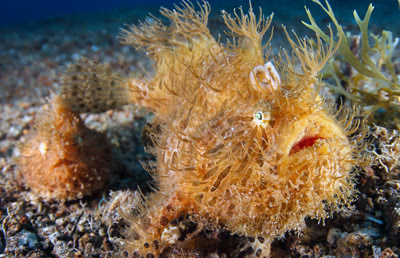Frogfish Facts
| Frogfish is a type of angelfish. There are 45 species of frogfish that can be found in the tropical and subtropical waters near the coasts of Africa, Asia, Australia and North America. Frogfish usually inhabits coral reefs, on a depth of 330 feet. Frogfish is a bottom-dweller that spends its life on the rocky sea floor. Despite accelerated habitat destruction and pollution of the sea, wild population of frogfish is still large and stable. |
| Interesting Frogfish Facts: |
|---|
| Frogfish can reach 1/8 to 22 inches in length, depending on the species. |
| Color of the body depends on the habitat. Frogfish can be white, yellow, beige, pink, green or black colored. It is able to quickly change the color of the body to blend with its environment. |
| Frogfish does not have scales. Unusual shape of the body and spines (or bumps) on the surface create impression of the sponge. |
| Frogfish has short, stocky body with upward pointed mouth and rounded dorsal fins and tail. |
| Frogfish is a carnivore (meat-eater). Its diet is based on the fish and crustaceans. |
| First spine of dorsal fin is modified into rod with twig, feather or worm-like lure called "esca" on the top. Frogfish wriggles the lure in front of the head to attract the prey. Lure can be regenerated in the case of damage. |
| Frogfish is an ambush predator which hunts the prey using the element of surprise. Once the prey is close enough, frogfish swallows it in a blink of an eye (attack lasts 6 milliseconds). |
| Frogfish can swallow the prey that is 2 times bigger than the fish itself thanks to ability to expand the mouth 12 times of its normal size. Frogfish does not have teeth and it swallows the prey in one piece. |
| Frogfish rarely swims. It usually walks on the sea floor using the modified pectoral fins. |
| Natural enemies of frogfish are large species of frogfish and moray eel. |
| Frogfish can inflate the body to startle the predators. |
| Frogfish is a solitary creature. It can be found with other frogfish only during the mating season. Fertilization takes place in the water (where males and females release their reproductive cells). Female produces 40.000 to 180.000 per season. |
| Eggs are laid in the mucus on the ocean floor. They are often called "veil" or "egg raft" due to ribbon-like shape of the mass of eggs and ability to float thanks to ocean currents. Fry emerge from the eggs 2 to 5 days after fertilization. Young fish are often colored like the poisonous sea slugs or flatworms (to ensure protection against predators). |
| Some species of frogfish do not show parental care, while others guard the eggs until they hatch. Some males carry eggs in between the hairs, bumps and other structures on the body. |
| Frogfish can survive up to 20 years in the wild. |
:o)


I had a boss that looked like the last one! LOL! (
ReplyDelete